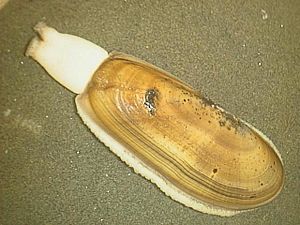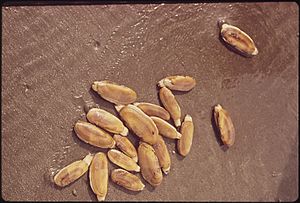Pacific razor clam facts for kids
Quick facts for kids Pacific razor clam |
|
|---|---|
 |
|
| A live Pacific razor clam in water | |
 |
|
| A group of Siliqua patula dug from Quinault Beach, Washington state | |
| Scientific classification | |
| Genus: |
Siliqua
|
| Species: |
patula
|
The Pacific razor clam, also known as Siliqua patula, is a fascinating sea animal. It is a type of large clam that lives in the ocean. These clams are a kind of mollusc, which is a group of soft-bodied animals. They are also bivalves, meaning their shells have two parts that open and close like a book.
Where Pacific Razor Clams Live
You can find Pacific razor clams along the Pacific West Coast of North America. Their home stretches from the eastern Aleutian Islands in Alaska all the way down to Pismo Beach, California.
These clams love sandy beaches. They live in the intertidal zone, which is the area of the beach covered by water at high tide and exposed at low tide. They can also be found in water up to about 9 meters (30 feet) deep.
What Pacific Razor Clams Look Like
The Pacific razor clam has a long, narrow shell that looks a bit like an old-fashioned straight razor. This is how it got its name! In the southern parts of its range, these clams usually grow to be about 8 to 15 centimeters (3 to 6 inches) long. However, in Alaska, some can grow much larger, up to 28 centimeters (11 inches) long!
There are other clams called "razor clams" too. For example, the Atlantic razor clam (Siliqua costata) lives on the East Coast of the United States. Another one is the Atlantic jackknife clam (Ensis directus). Even though they share the "razor clam" name, the Pacific razor clam is in a different group (genus) than the jackknife clam.
Eating Pacific Razor Clams
Pacific razor clams are a very popular seafood! Many people enjoy collecting them for fun, and some companies also harvest them to sell.
When collecting razor clams, it's very important to be safe. Sometimes, clams can have harmful natural toxins, like domoic acid. These toxins can make people sick. So, before you ever collect razor clams, always check with local health officials. They will tell you if it's safe to harvest them.
In the United States, states often announce special times when it's okay to go clamming. People look for a "show" in the sand, which is a small hole or dip that shows where a clam is hiding. Sometimes, clams will stick out their breathing tubes (called siphons) when the waves go out. This is called "necking" and makes them much easier to spot!
Once collected, razor clams are often cooked in delicious ways. A common way to eat them is to batter and fry them in butter. They are also a popular ingredient in tasty clam chowder.

